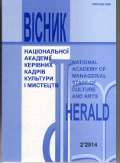BACKGROUND AND DEVELOPMENT OF LIMOGES PAINTED ENAMEL
DOI:
https://doi.org/10.32461/2226-3209.2.2014.137982Keywords:
arts and crafts, hot enamel, champleve enamel, painted enamel, pilgrimage, medieval, renaissanceAbstract
This article deals with the development oflimogespainted enamel in the socio-cultural context. Actuality of the study of painted enamels ofFranceitself, lies in its wide acknowledgement in western Europe, and that it has become the basis for the emergence and development of painted enamel inUkraineandRussia– the finift.Limogespainted enamel remains largely unknown. While Renaissance sculpture and painting are well studied, most works systematically studied, the enamel, it would seem, lays long forgotten. Main subject of this article is the development oflimogeshot enamel in social and cultural context inEurope. The object of study is emergence and development oflimogespainted enamel during changing historical periods and European intercultural dialogue. To understand the pre-conditions and conditions of painted enamel , it is necessary to consider historical and cultural situation and the synthesis of various art forms as factor for development of painted enamel. Therefore, the article emphasizes economic and political importance ofLimoges, as one of cultural centers of Christian Europe.
Development of painted enamel had its own particularities. The basis of a new technology, namely painted enamel, were rich tradition of manufacturing notched enamels, stained glass, jewelry art and medieval philosophy, but the development and blossoming takes place in the new Renaissance culture and is influenced by European intercultural dialogue. Painted enamel is related to decorative arts, but always developed in close connection with drawing and painting. Demand for works oflimogesenamel determined path of its development. Which was, in turn, shaped by changes in artistic tastes of clients and reflects transformation of public consciousness.
The article focuses on the history and development factors forlimogespainted enamel. It is usually divided as the Old andNewSchoolart. The basis of the art of the Old School, which covers second half of the XV century – first quarter of the XVI century, is founded by previous works in cloisonne enamel and stained glass art principles. In the works of the old school, transition from Gothic to Renaissance motifs is noticeable. Old School is based on medieval religious world view. Essentially all medieval art, painted enamel works of Old School are largely all religious, diversity of the story limited to gospel themes, most of them anonymous.
New School broke traditions and medieval art became a new historical period that embodies Renaissance philosophy and developed in the context of pan-cultural processes throughoutEurope. Cult religious themes are giving way to modern subjects of interior, decorated with allegorical images or illustrations of a specific literary work , such as the myth of the Argonauts – plates, jug , bowl etc.. Great influence on then painted enamel were engravings, artists not only copying plots of stories, but also as if trying to simulate an engraving in itself in their work. However, change was not only of the style of works, but outlook of their authors, understanding of their art – most of the works ofNewSchooland dated and signed, sometimes one and the same piece is signed several times, moreover, quite often works carry emblems of its owners. From now on, it is not anonymous medieval art but new art, adopted to suit the person of Renaissance.
Consequently, painted enamel in France has started from rich traditions of making notched enamels, stained glass and jewelry, and is based more on the medieval world view, but its flourishing times are those of Renaissance. Development of painted enamel falls in that time of socio-cultural context and, the major factor is that it appears as a synthesis of trends of different art forms. Due to demand for certain pieces painted enamel appears to have undergone social transformation and change of aesthetic preferences, and actually formed and developed various schools and trends in this kind of artistic activity.
Furthermore,Limogespainted enamel affected considerably development of similar art far beyondFrance, includingUkraine.
Downloads
Published
Issue
Section
License
Authors who publish with this journal agree to the following terms:
1. Authors retain copyright and grant the journal right of first publication with the work simultaneously licensed under a Creative Commons Attribution License International CC-BY that allows others to share the work with an acknowledgement of the work's authorship and initial publication in this journal.
2. Authors are able to enter into separate, additional contractual arrangements for the non-exclusive distribution of the journal's published version of the work (e.g., post it to an institutional repository or publish it in a book), with an acknowledgement of its initial publication in this journal.
3. Authors are permitted and encouraged to post their work online (e.g., in institutional repositories or on their website) prior to and during the submission process, as it can lead to productive exchanges, as well as earlier and greater citation of published work (See The Effect of Open Access).


